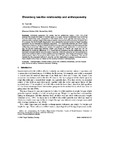Please use this identifier to cite or link to this item:
http://hdl.handle.net/10311/1055Full metadata record
| DC Field | Value | Language |
|---|---|---|
| dc.contributor.author | Forcheh, N. | - |
| dc.date.accessioned | 2012-11-16T06:11:12Z | - |
| dc.date.available | 2012-11-16T06:11:12Z | - |
| dc.date.issued | 2002 | - |
| dc.identifier.citation | Forcheh, N. (2002) Ehrenberg law-like relationship and anthropometry, Journal of the Royal Statistical Society. Series A (Statistics in Society), Vol. 165, No. 1, pp.155-172 | en_US |
| dc.identifier.uri | http://hdl.handle.net/10311/1055 | - |
| dc.description | Symbols on the abstract may differ from the original abstract | en_US |
| dc.description.abstract | Summary. Ehrenberg presented the simple law-like relationship log(w) = 0.8h + 0.4 ? 0.04 between the weight and height of children aged 5-13 years. Several researchers have confirmed that this relationship holds, irrespective of the child's ethnic, racial, gender and social class. In anthropometry, a weight-height relationship is used to measure the nutritional status of children. For this purpose, the World Health Organization have adopted the National Center for Health Statistics population as the international reference population. The relationship between the World Health Organization-National Center for Health Statistics anthropometric standards and Ehrenberg law-like relationship is examined. Differences between the weight-for-height relationship in anthropometry and the law-like relationship between weight and height for children are small and can be attributable to functional differences. It is found that an Ehrenberg law-like relationship can be extended to include children who are under 5 years old. Criteria for using the law-like relationship to assess the nutritional status of these children are thus suggested. The criteria are evaluated using anthropometric data of a sample of 513 children from a rural district of Botswana. The results indicate that the proposed method of using the law-like relationship to assess nutritional status is much simpler and at least as reliable as the existing methods in anthropometry. | en_US |
| dc.language.iso | en | en_US |
| dc.publisher | Wiley-Blackwell, www.wiley.com/wiley-blackwell | en_US |
| dc.subject | Anthropometry | en_US |
| dc.subject | Children under 5 years old | en_US |
| dc.subject | D-statistics | en_US |
| dc.subject | Ehrenberg | en_US |
| dc.subject | Law-like relationship | en_US |
| dc.subject | Nutritional status | en_US |
| dc.subject | Reference standard | en_US |
| dc.subject | Wasting | en_US |
| dc.subject.lcsh | Anthropometry | en_US |
| dc.title | Ehrenberg law-like relationship and anthropometry | en_US |
| dc.type | Published Article | en_US |
| dc.link | http://www.jstor.org/stable/3559766 | en_US |
| Appears in Collections: | Research articles (Dept of Statistics) | |
Files in This Item:
| File | Description | Size | Format | |
|---|---|---|---|---|
| Forcheh_JRSS.A_2002.pdf | 2.53 MB | Adobe PDF |  View/Open |
Items in DSpace are protected by copyright, with all rights reserved, unless otherwise indicated.
